Zebrafish, a unique group of vertebrates, have an extraordinary ability to fully heal a severed spinal cord, providing valuable insights into potential therapies for spinal cord injuries in humans. Understanding the mechanisms behind this remarkable regeneration could pave the way for innovative treatments, potentially transforming the lives of those suffering from such devastating injuries.
A groundbreaking study conducted by researchers at Washington University School of Medicine in St. Louis has unveiled a comprehensive atlas detailing the cells and processes involved in zebrafish spinal cord regeneration. Contrary to common assumptions, the study revealed that the survival and adaptability of injured neurons are crucial for successful spinal cord regeneration. This discovery challenges the traditional belief that stem cells are the primary drivers of regeneration, highlighting their supportive but not leading role in the process.
The study, published in Nature Communications on August 15, 2024, showcases how zebrafish neurons, unlike their mammalian counterparts, undergo significant changes following spinal cord injury. These changes enable the neurons to not only survive but also to take on new roles that are essential for orchestrating the healing process. This newfound understanding of zebrafish spinal cord regeneration provides a promising avenue for developing strategies to heal spinal cord injuries in humans.

Senior author Mayssa Mokalled, PhD, an associate professor of developmental biology, explains, “Most, if not all, aspects of neural repair that we’re trying to achieve in people occur naturally in zebrafish. We’ve observed robust neuronal protection and repair mechanisms immediately after injury. These mechanisms allow neurons to survive and adopt a flexible role that ultimately leads to full recovery. Our study has identified genetic targets that could help us promote similar plasticity in human and other mammalian cells.”
By meticulously mapping out the roles of various cell types in the regeneration process, Mokalled and her team discovered that the flexibility and reprogramming capacity of the surviving injured neurons are the driving forces behind spinal cord regeneration in zebrafish. Without these neurons, even the presence of regenerative stem cells isn’t enough to restore normal function, such as swimming ability.
In contrast, when the spinal cord is damaged in humans and other mammals, it triggers a toxic cascade that kills neurons and creates a hostile environment for repair. This toxicity might explain why stem cell therapies for spinal cord injuries have so far been unsuccessful. The study suggests that any effective treatment must first focus on protecting injured neurons from death, rather than solely relying on stem cells for regeneration.
Mokalled emphasizes, “Neurons can’t survive on their own; they need connections to other cells. In zebrafish, we believe that severed neurons manage to survive the stress of injury by forming new connections almost immediately. This temporary mechanism protects neurons, preserving the spinal cord’s circuitry while the regeneration process unfolds.”
The researchers believe that this capacity for survival and regeneration might exist in mammalian neurons, albeit in a dormant state. If so, it could open up new therapeutic avenues for treating spinal cord injuries in humans.
“We are optimistic that by identifying the genes responsible for this protective process in zebrafish—genes that also exist in humans—we can develop strategies to shield human neurons from the widespread cell death that typically follows spinal cord injuries,” Mokalled said.
While the current study focuses on neurons, the complexity of spinal cord regeneration means there is much more to explore. Mokalled’s team plans to delve into the roles of other cell types, such as glial cells in the central nervous system and cells from the immune system and vasculature. They are also comparing their findings in zebrafish with observations in mammalian cells, including those from mice and humans.











